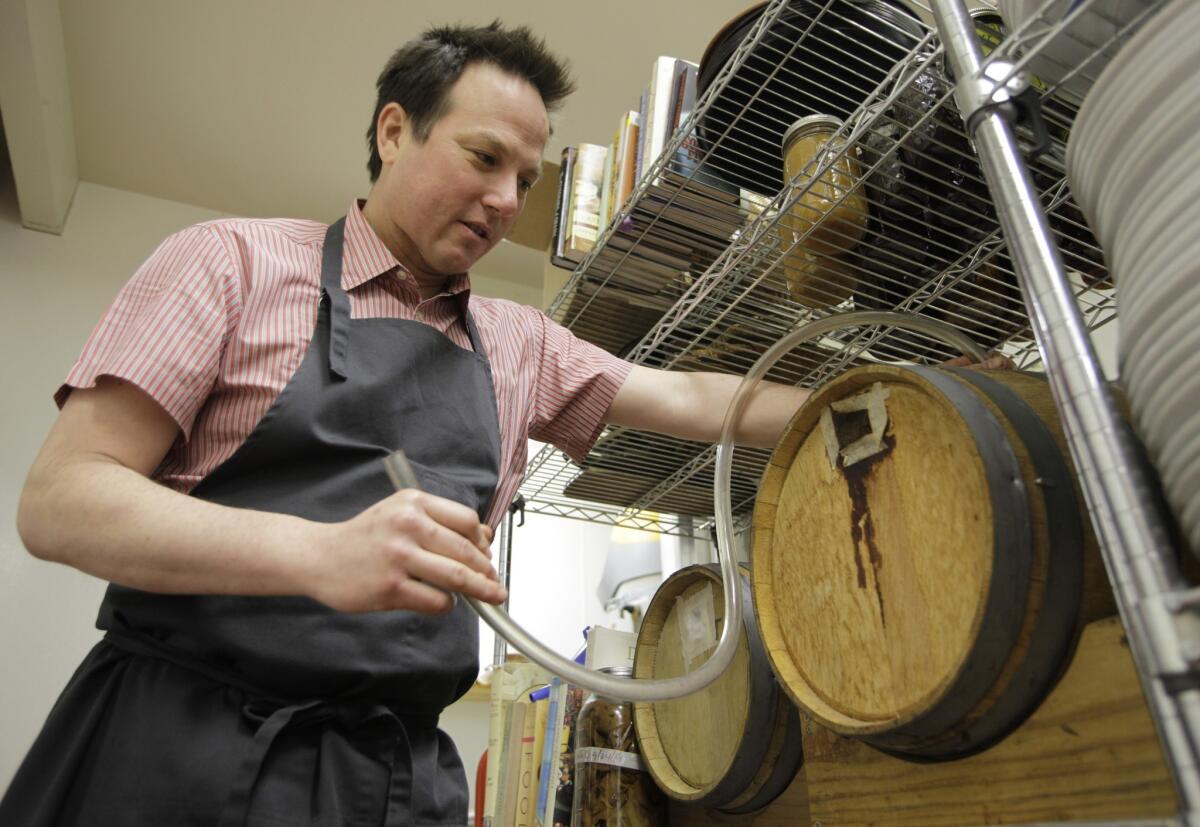What we’re into: Camino red wine vinegar, chef Russell Moore’s vinegar baron retirement plan
- Share via
The last days of Camino, the Oakland restaurant run by chef Russell Moore and his wife, Allison Hopelain, that closed last month after a 10-year run, were like a boisterous wake.
Folks who had worked there in the past returned to their old jobs, or to help with what turned out to be nightly farewell parties. The long, wooden communal tables filled with friends, colleagues and locals, gathering for a last supper of the hearth-driven, vegetable-intensive cooking that had made the place one of the best restaurants in Bay Area, if not California. And as the tables filled, the shelf near the door stocked with bottles of Camino’s cult-status red wine vinegar emptied out — a parting gift, an exit strategy.
“I had always made vinegar at home,” Moore said recently at the Kebabery, the cozy Oakland kebab shop he and Hopelain opened in 2017 and now run as part of their post-Camino retirement plan. (They plan to open a second Kebabery in Berkeley this year, and likely more after that.) But Moore had been a vinegar junkie long before Camino opened.
“I tried to make it at Chez Panisse a couple times,” Moore said about his early vinegar experiments during the 21-year run he had as chef at Alice Waters’ Berkeley restaurant. “But it was hard to sell to the rest of the crew. So we ramped up production in a really, really tiny barrel at Camino before we opened. And I told the cooks: This is the vinegar we have; we’re not buying any other.”
It’s heady stuff, aged in oak barrels for at least four months and often up to a year. At the restaurant, Moore favored using what wine was around to make his vinegar: leftovers from tastings or from parties, bottles that were open or available, an eclectic sampling from a variety of grapes. The original Camino batch was made from an old bottle of vinegar that Moore had bottled back in the Chez Panisse days, left under his house, and then forgotten about; that, in turn, had been made from another old bottle of vinegar. (Not unlike sourdough, live vinegar is used to make more vinegar.)
“I mean, the book tells you how to make it,” Moore says of the vinegar recipe included in the larder section of the excellent cookbook “This is Camino” from 2015. He says he’s given away “hundreds” of bottles of his vinegar over the years, often to people who want to make their own using his as a starter.

“The chef boys are the worst at it. They’re like fancy tweezer boy tasting menu restaurants. And I feel like, OK, you just have to give me back a bottle, like a year from now. Never got a bottle back. A couple home people make it; I think those are going well. I have gotten bottles back from them.”
And although you can indeed take your $28 bottle of Camino vinegar — or other good, unpasteurized vinegar — add three bottles of red wine and a half a bottle of water, barrel it and wait four months, as his recipe instructs, most of us would vastly prefer to buy a bottle of Moore’s.
“I want to keep making it, so I might as well keep selling it,” said Moore, who a few days before had just made another barrel to meet the post-Camino demand. “It’s hard to stop these weird projects that I did at Camino. We might sell the hot sauce too.”
As for where he’ll get his supply of red wine now that he doesn’t have a big, wine-intensive restaurant, he says that he’ll still get the same stuff — “organic wine that’s good” — from his old wine connections.
“We buy it, but sometimes some stuff is tossed our way; we might trade some vinegar for it. Once you’re used to having really good strong red wine vinegar, it’s hard to buy the crappy stuff at the stores.”
I first heard about Camino’s vinegar a few years ago, when I asked the late Jonathan Gold if he wanted me to bring him back anything from a trip to the Bay Area.
“Vinegar,” he’d said, and directed me to Camino, where he’d sent me for dinner on a previous trip. (“You’re going there?” he’d asked of another restaurant I’d picked out. “Why, when you can go to Camino?”)
So I brought Gold back one bottle and another for myself, and quickly became hooked. Bottles of it operate like currency in Los Angeles, appearing among the shelves filled with chocolate and olive oil at Lincoln and Little Flower in Pasadena — owner Christine Moore had driven up to Oakland to bring back a carload of the vinegar for the holidays — and at Cookbook in Echo Park. At the downtown restaurant Broken Spanish, a dish of seared foie gras, made shortly before the ban on foie gras took effect again in California, was paired with a sauce made with Camino vinegar.
“It’s also part of the retirement plan,” Moore said, breaking out into a wide grin. “Vinegar baron.”
Where to buy Camino vinegar: Camino’s online store, Preserved and Umami Mart in Oakland. In L.A., Cookbook: 1549 Echo Park Ave., Los Angeles, (213) 250-1900, cookbookla.com; Lincoln: 1992 Lincoln Ave, Pasadena, (626) 765-6746, lincolnpasadena.com; Little Flower: 1424 W Colorado Blvd, Pasadena, (626) 304-4800, littleflowercandyco.com.
More to Read
Eat your way across L.A.
Get our weekly Tasting Notes newsletter for reviews, news and more.
You may occasionally receive promotional content from the Los Angeles Times.










